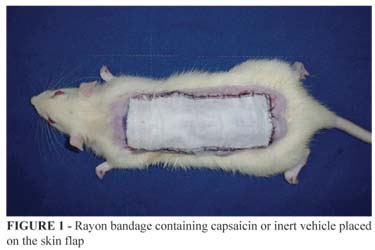Abstracts
PURPOSE: To evaluate the effects of capsaicin on the viability of ischemic random-pattern skin flaps in rats. METHODS:Forty EPM1-Wistar rats were randomized into two groups of 20 animals each, the capsaicin group and the control group. A random-pattern skin flap measuring 10 x 4cm was raised and a plastic barrier was placed between the flap and the donor site. After the surgical procedure, the control group was treated with an inert vehicle in the form of a cream applied uniformly to a rayon bandage which, in turn, was applied to the surface of the skin flap. The capsaicin group was treated in the same way, but in this case capsaicin was added to the cream. This procedure was repeated for two consecutive days. RESULTS: There was a significantly smaller amount of flap necrosis in the capsaicin group (35.07%) than in the control group (44.75%) (p=0.035). CONCLUSION:Topical administration of capsaicin improved the viability of ischemic random-pattern skin flaps in rats.
Capsaicin; Surgical Flaps; Neuropeptides; Necrosis; Rats

 Capsaicin on the viability of random-pattern skin flaps in rats
Capsaicin on the viability of random-pattern skin flaps in rats
